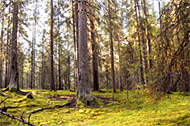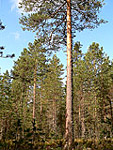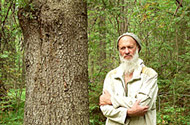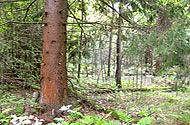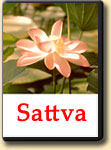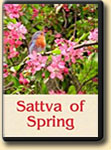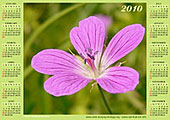The Highest Yoga
|
Eco Life:
|
About Work with PlantsWe talk to you all the time about love. It is not possible to come to God without having learned to love His Creation and then God Himself. Love is altruism, a giving of oneself! The true love can not be egocentric! “Love” for oneself is a perversion of the very idea of love! On the spiritual Path there cannot be a formula such as: “I love you, therefore you have to belong to me and love me!” We can learn the true altruistic love in the sphere of sexual relationships, in the upbringing of children, through service to people in the workplace (if we regard our work as a service rather than a means of making money and getting other boons), and even when waiting in line for something of which very little is left and we see that another one needs this more than we do… Love as compassion, tenderness, patience, readiness for self-sacrifice and so on is the basis of ethics. And the ethical component is the foundation, the pivot of a growing spiritual person. Not only spiritual leaders can help us learn to love, not only other people, but ordinary plants as well — if we want to learn it! Plants also are living beings, which are even capable of reacting emotionally! Plants, as we are, are physical bodies with incarnated units of life in them; they are evolving souls going through the vegetal level of development. It is in this way that we have to regard plants if we want to learn love! Plants are also living beings! And we can learn to love any such being, thus developing the capacity for emotional love in ourselves! The more objects every one of us has learned to love — the wider, more perfect our love will be! But there are other possibilities of esoteric work with plants. For example, every plant, like any other incarnated being, has a bioenergy shell — a cocoon — around its body. One can train oneself in perceiving the bounds of cocoons with the hands; one can develop clairvoyance by trying to learn to see them. And it is easier to see cocoons of other beings from one’s own cocoon having spread the consciousness in it. But there are even more interesting possibilities. For example, for training oneself as a consciousness, one can become a tree. To do this, one has to stand, for example, at the tree’s trunk, the back turned towards it, attune to the tree with emotional love — and “flow” with the consciousness from anahata through the back into the body of the tree. Then we can easily experience ourselves as a pine, for example; we can look at the world around from its body, as if with its eyes. At that, one’s “I” disappears. It is extremely important to learn to disappear! There is an opposite way typical of some occult and black magic schools — the way of growing one’s “I”: “I am the master here! I will command! Everyone has to revere me!…” Contrary to this, in sound religious schools they cultivate lowliness of mind — lowly sense of oneself. And this is not a dogmatic goal as an end in itself! There is a really principal meaning in this. One becomes able to merge with God and thus to finish victoriously the personal evolution only having learned to be nothing, having learned to disappear — to disappear in God: disappear in Him in order to become Him! One cannot “break into” God. One can only disappear in God. This is why in buddhi yoga the stage of Nirvana in Ishvara is preceded by the stage of Nirodhi where one learns to transfer the “I” into the state of “non-I”. One should keep this in mind from the very beginning of the Path and be very cautious about the growth of arrogance, pride, egocentrism in oneself. Otherwise it will be very difficult to overcome it later. … Also with the help of plants we can become subtler by attuning to them. Plant species differ in the subtlety-coarseness characteristic. For instance, the oak is energetically the coarsest type of trees of the North European part of Russia. On the contrary, pines, spruces, birches (namely, downy birch species), some poplars — one can learn much from them! He who easily falls into the coarse energetic states, who is not able of abandoning them cannot be called a spiritual person! But the trees mentioned above always live in the state of calm and subtlety! Bioenergetical activity of a tree depends on the season. Birches give their subtlety to us most intensely in spring, in the period of active sap movement. The best season for working with pines is summer, when it is hot. And it is better to work with spruces during the cool seasons of the year. There exist also bioenergetical differences between plants of the same species. Plants growing in unfavorable conditions, for example in thicket or on inadequate soil, etc, are weak bioenergetically. And healthy, sound trees growing in open space are usually full of energy. * * * And in conclusion of this chapter, let us dwell on the ethics of relationships with plants. Some bioenergetical specialists in Russia fantasized that some trees share their energy and other trees take energy. And that one can get energy from the former and should beware of the latter as of “vampires” and so on. One of the reasons for such a fantasy is scarcity of information that can be obtained with the help of a dowsing rod and pendulum compared to the possibility of entering into harmonic relations of emotional love with plants, merging by the consciousness with them. In reality there are no plants whatsoever that “drain” energy from people! And we, too, have no ethical right to have the consumerist attitude toward the vital force of other living beings! Let us pay attention to this! This is the principal point of the spiritual ethics. On the spiritual path there is no place for consumerism! There is only place for love-giving, love-harmony! The one who advances spiritually establishes relationships of love with plants. Let us approach a tree with love, attune with it in the harmony of subtle emotions, give to it our love-tenderness, — and then it will respond with its love! Only when each one of the partners directs the vector of love not toward oneself, but toward the partner — only then is it possible to achieve the true harmony between a human and a plant, between a human and a human, between a human and God! Vladimir Antonov, Ph.D. (in biology) Translated from Russian |
|

